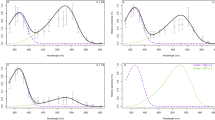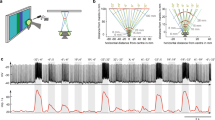Summary
Photoreceptors and monopolar cells in the ventral eye ofSympetrum rubicundulum have been recorded from intracellularly and stained with Lucifer yellow. Units with four types of spectral sensitivity were found having λmax at 340, 410, 490–540 and 620 nm. On the basis of a significant difference in half bandwidth ofS(λ), the green receptors are separable into two subgroups with λmax at 490 and 540 nm. The fluorescence marking reveals that R5/8 and R2/3 are the green receptors; R1/4 is either a UV or an orange cell. Discrimination between the members of the three matched pairs R2 & 3, R5 & 8, and R1 & 4 has not been possible. R7 is the violet receptor, and R6 is probably an additional green receptor; these are the receptors with long visual fibres. No receptors in the ventral eye besides the orange (620 nm) are sensitive to polarized light, whereas UV receptors in the dorsal eye are highly sensitive to polarized light. The polarized light sensitivity of the orange receptors is interpreted as an adaptation to increase the contrast between a conspecific animal and shorter wavelength light with a predominantly horizontal E-vector, such as is provided by reflections on the water's surface.
Cell identification is complicated by the fact that in most cases more than one cell is dye-marked. We present evidence in favour of dye-coupling being functional and against it being any simple artifact. Most importantly, the cellular pattern of dye-coupling is related to the spectral sensitivity of the recorded unit.
Recordings from monopolar cells are interpretable in the light of the results of both receptor markings and the anatomical pattern of their synaptic connectivities. The significance of a previously described asymmetry of the synaptic connections of the lamina terminals from R1 and R4 is now most easily understood as the counterpart of a duality in the spectral properties of this receptor pair; whether UV- or orange-sensitive types coexist within a single ommatidium or are segregated between different ommatidia is, however, not known.
Similar content being viewed by others
Abbreviations
- S(λ):
-
spectral sensitivity
- λmax :
-
wavelength of maximum sensitivity
- V max :
-
maximum response size
- P.S. :
-
polarization sensitivity
- D :
-
dorsal
- V :
-
ventral
References
Armett-Kibel C, Meinertzhagen IA (1983) Structural organization of the ommatidium in the ventral compound eye of the dragonflySympetrum. J Comp Physiol 151:285–294
Armett-Kibel C, Meinertzhagen IA, Dowling JE (1977) Cellular and synaptic organization in the lamina of the dragon-flySympetrum rubicundulum. Proc R Soc Lond [Biol] 196:385–413
Autrum H, Kolb G (1968) Spektrale Empfindlichkeit einzelner Sehzellen der Aeschniden. Z Vergl Physiol 60:450–477
Boschek CB (1971) On the fine structure of the peripheral retina and lamina ganglionaris of the fly,Musca domestica. Z Zellforsch Mikrosk Anat 118:369–409
Cummins D, Goldsmith TH (1981) Cellular identification of the violet receptor in the crayfish eye. J Comp Physiol 142:199–202
Ebrey TG, Honig B (1977) New wavelength dependent visual pigment nomograms. Vision Res 17:147–151
Eguchi E (1971) Fine structure and spectral sensitivities of retinular cells in the dorsal sector of compound eyes in the dragonflyAeschna. Z Vergl Physiol 71:201–218
Hardie RC (1979) Electrophysiological analysis of fly retina. I. Comparative properties of Rl-6 and R7 and 8. J Comp Physiol 129:19–33
Hardie RC, Franceschini N, Mclntyre PD (1979) Electrophysiological analysis of fly retina. II. Spectral and polarisation sensitivity in R7 and R8. J Comp Physiol 133:23–39
Horridge GA (1969) Unit studies on the retina of dragonflies. Z Vergl Physiol 62:1–37
Krogh A, Weis-Fogh T (1951) The respiratory exchange of the desert locust (Schistocerca gregaria) before, during and after flight. J Exp Biol 28:344–357
Laughlin SB (1973) Neural integration in the first optic neuropile of dragonflies. I. Signal amplification in dark-adapted second-order neurons. J Comp Physiol 84:335–355
Laughlin SB (1974) Neural integration in the first optic neuropile of dragonflies. II. Receptor signal interactions in the lamina. J Comp Physiol 92:357–375
Laughlin SB (1976a) Neural integration in the first optic neuropile of dragonflies. IV. Interneuron spectral sensitivity and contrast coding. J Comp Physiol 112:199–211
Laughlin SB (1976b) The sensitivities of dragonfly photoreceptors and the voltage gain of transduction. J Comp Physiol 111:221–247
Laughlin SB (1981) Neural principles in the visual system. In: Autrum H (ed) Comparative physiology and evolution of vision in invertebrates. Springer, Berlin Heidelberg New York (Handbook of sensory physiology, vol VII/6B, pp 133–280)
Laughlin SB, Hardie RC (1978) Common strategies for light adaptation in the peripheral visual systems of fly and dragonfly. J Comp Physiol 128:319–340
Meinertzhagen IA, Armett-Kibel C (1982) The lamina monopolar cells in the optic lobe of the dragonflySympetrum. Philos Trans R Soc Lond [Biol] 297:27–49
Meinertzhagen IA, Menzel R, Kahle G (1981) The identification by lucifer injection of spectral inputs to the lamina cartridge of the dragonfly compound eye. Biol Bull 161:349
Menzel R (1974) Spectral sensitivity of monopolar cells in the bee lamina. J Comp Physiol 93:337–346
Menzel R (1979) Spectral sensitivity and colour vision in invertebrates. In: Autrum H (ed) Comparative physiology and evolution of vision in invertebrates. Springer, Berlin Heidelberg New York (Handbook of sensory physiology, vol VII/ 6A, pp 503–580)
Menzel R, Blakers M (1975) Functional organisation of an insect ommatidium with fused rhabdome. Cytobiol 11:279–298
Needham JG, Westfall MJ (1954) A manual of the dragonflies of North America (Anisoptera). University of California Press, Berkeley
Ribi WA (1975) The neurons of the first optic ganglion of the bee (Apis mellifera). Adv Anat Embryol Cell Biol 50:1–43
Ribi WA (1981) The first optic ganglion of the bee IV. Synaptic fine structure and connectivity patterns of receptor cell axons and first order interneurones. Cell Tissue Res 215:443–464
Shaw SR (1975) Retinal resistance barriers and electrical lateral inhibition. Nature 255:480–483
Shaw SR (1981) Anatomy and physiology of identified non-spiking cells in the photoreceptor-lamina complex of the compound eye of insects, especially Diptera. In: Roberts A, Bush BMH (eds) Neurones without impulses. Cambridge University Press, Cambridge (Soc Exp Biol Seminar Series 6:61–116)
Spurr AR (1969) A low-viscosity epoxy resin embedding medium for electron microscopy. J Ultrastruct Res 26:31–43
Stewart WW (1978) Functional connections between cells as revealed by dye-coupling with a highly fluorescent naphthalimide tracer. Cell 14:741–759
Stewart WW (1981) Lucifer dyes — highly fluorescent dyes for biological tracing. Nature 292:17–21
Strausfeld N, Campos-Ortega JA (1977) Vision in insects: pathways possibly underlying neural adaptation and lateral inhibition. Science 195:894–897
Zettler F, Autrum H (1975) Chromatic properties of lateral inhibition in the eye of a fly. J Comp Physiol 97:181–188
Zimmermann K (1914) Über die Facettenaugen der Libelluliden, Phasmiden und Mantiden. Zool Jahrb Abt Anat Ontog Tiere 37:1–36
Author information
Authors and Affiliations
Rights and permissions
About this article
Cite this article
Meinertzhagen, I.A., Menzel, R. & Kahle, G. The identification of spectral receptor types in the retina and lamina of the dragonflySympetrum rubicundulum . J. Comp. Physiol. 151, 295–310 (1983). https://doi.org/10.1007/BF00623906
Accepted:
Issue Date:
DOI: https://doi.org/10.1007/BF00623906




